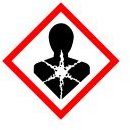Are There Cancer Causing Ingredients in Sunscreen?
Cancer Causing Ingredients in Sunscreens?
Some of the chemical ingredients in sunscreens are totally prohibited by the FDA. Other synthetic chemicals may be included among the FDA prescribed and regulated chemical substances but are harmful only if used in levels beyond what is regulated. However, hazard warnings are still up since their toxic effects will depend on the consumer’s frequency of application or use. There are in fact, thousands of chemical substances and derivatives used in different industries and more than a hundred of them have been found as cancer causing ingredients in sunscreens.
Below are examples of these carcinogenic ingredients in sunscreen, which were selected based on their higher hazard ratings. There are also those with moderate hazard ratings but were included because they are known to be widely or frequently used.
Benzophenone-3 or Oxybenzone : Hazard Rating - High

Studies made by Centers for Disease Control Research show that this chemical ingredient contaminates 97% of American bodies. It is found to be used as a sunscreen agent, ultraviolet absorber and ultra violet filter in sunscreen SPF 15-30, sunscreen SPF greater than 30, sunscreen moisturizer, sunscreen lip balm and baby sunscreen.
Benzophenone-3 is included among those listed in the Registry of Toxic Effects of Chemical Substances. Concerns about this chemical include wildlife and environmental toxicity and its ability to absorb into the skin and to cause endocrine disruption.
Other studies show that this synthetic chemical suppresses growth, causes leucocytosis, anemia, and can reduce organ weight and both chronic/sub-chronic oral toxicity. There are about 1,388 studies in PubMed science library that may provide data regarding the toxicity of this chemical. There are 1,217 sunscreen and other consumer products that carry these ingredients with hazard ratings that range from moderate to high.
Benzophenone-2: Hazard Rating - Moderate
According to the Skin Deep Database, this cancer causing substance in sunscreen is being used as a fragrance, UV Light absorber and masking substance. However, this synthetic chemical is not approved in the U.S. for use as a sunscreen ingredient due to strong evidence of hormonal disruption to both human and wildlife. These are based on studies made by the European Commission on Endocrine Disruption. The Cosmetic Ingredients Review disclosed that there is also strong evidence that it is a human skin toxicant. Frequency of application as a sunscreen which will equate to high doses can have immunomodulatory effects. (This refers to the prevention of auto-immunity development wherein suppression of immunity responses can take places).
In addition, the Registry of Toxic Effects of Chemical Substances classifies this synthetic formulation under its toxicology report as a mutagenic toxic substance. There are about 93 consumer products including sunscreens that make use of this cancer causing agent as an ingredient.
PABA or Para-Aminoabenzoic Acid: Hazard Rating - High

This is commonly used as a sunscreen agent, UV light absorber, UV absorber and UV filter. PABA is a known carcinogenic; hence, some manufacturers are now using only its derivatives. Although there are still several health concerns regarding its use; the FDA classifies this substance as “safe for general or specific, limited use." The Registry of Toxic Effects of Chemical Substances has concerns about its link to cancer due to positive results of animal lab tests for cell mutations. Currently, there is no data about it being a cancer causing ingredient in sunscreen, but there are still 10 consumer products in the market that contain this synthetic chemical.
Octinoxate (Octyl Methoxycinnamate): Hazard Ranking - Moderate to High
This chemical substance is not directly linked by the Skin Deep Database to cancer but there are several major concerns regarding its use as a sunscreen ingredient. Touted as the most widely used synthetic chemical in sunscreen products, it is found in sunscreens as a UV Absorber and UV Filter. The European Commission on Endocrine Disruption disclosed that there is strong evidence of its effect as a human disruptor. Based on Japan’s Standards for Cosmetics, its use is restricted in cosmetics and subject to concentration limits and manufacturing restrictions in some types of cosmetics. Health concerns include cell mutations, liver, photoallergic effects, liver effects and wildlife and environmental toxicity. There are about 2,097 sunscreen and other consumer products that contain this toxic chemical substance.
Other Information about Hidden Dangers of Sunscreen that Consumers Should Know
- EWG has tested and confirmed 74 sunscreen products with SPF from 55-100+ that give a false sense of security regarding its ability to protect the human skin from the harmful UVR. Test results showed that these products are capable of blocking only around 1 to 2% of UV radiations.
- Certain sunscreen products are ineffective because they breakdown under the sun. Look for products that mention “stability” aside from checking its chemical composition with the database for cancer causing ingredients in sunscreens.
- About 38% of sunscreen products that are commercially available are misbranded since the FDA does not strictly supervise its labeling regulations.
- Other chemical compositions might not be linked to cancer but their inclusion as sunscreen ingredients can cause the release of free radicals when exposed to sunlight.
To find out the different sunscreen brands that contain the harmful cancer-causing ingredients mentioned above, you can go to the Skin Deep Database at www.cosmeticsdatabase.com and click on the product results.
Reference Materials
- https://www.ewg.org/cosmetics/report/sunscreen09/investigation/summary-of-findings
- https://hubpages.com/hub/Toxic-Sunscreen-and-Non--Toxic-Sunscreens
- https://www.greenlivingtips.com/articles/127/1/Sunscreen---protection-or-poison.html
- https://www.healthhype.com/harmful-sunscreen-ingredients.html
- www.cdc.gov/niosh/rtecs/RTECSaccess.html -
- https://www.nrdc.org/health/effects/qendoc.asp
Images courtesy of Wikmedia Commons
This post is part of the series: All About Sunscreen Safety Checks
Using sunscreen is very important but you need to do some safety checks to make sure you’re using the right type of safe sunscreen. Checkout this series and learn about sunscreen safety checks and the natural oils you can use as alternatives in sunscreen protection.
